
I had always intended to do a tutorial on my Halloween spiders for you all, but I just didn't fancy repeating the same cookies. So I set to thinking how I could change things a bit, and do something different. Well, for a start, I wanted to have a bit of fun with the colours, and avoid the traditional black, green, and orange (maybe a little orange!). And what I ended up with was positively Christmassy. Well, why not?
What you will need:
- Baked cookies of your choice
- White thick flood (20-second) royal icing
- Brightly coloured royal icing in pink, turquoise, and orange (or any other bright colour you fancy) in both 20-second and stiff consistencies
- Nozzles (aka tips) in 1 and 1.5 size
- Scribe tool
- Tweezers
- DragÉes or sugar pearls in a range of colours and two sizes
- Coloured boiled sweets (aka hard candy)
- Baking (aka parchment) paper or greaseproof paper
- Plastic bag
- Hammer!
- A little flavourless oil
A note on colours: I used Sugarflair gel colouring in Pink, Melon Yellow, and Ice Blue to create the pink, orange, and turquoise icing. I actually deepened the colours for the legs, after piping the webs, as I wanted a brighter, zingier look.
A note on the icing: Using 20-second icing for both the flood and web lines will reduce bleeding and keep the lines thin, but will require quicker work, and a little effort with a scribe tool to reduce the peaks forming at the end of the lines.
A note on cookies: Of course you can use any shape, but I find straight-sided shapes much easier to outline and flood and so can do it quickly, which is important when there is wet-on-wet work to do. Fussing with the shape of a flooded circle can use up valuable pre-crusting time!
A note on dewdrops: These are very effective but will not last. They go sticky within minutes to hours depending on humidity. I would not attempt to package these cookies for posting (aka mailing) once the droplets are added, and would suggest adding them at the latest opportunity before presenting the cookies. I made mine the day before attaching them to the cookies and kept them on their little sheets in an airtight container that had a base layer of bicarbonate of soda beneath a sheet of baking paper to act as a dessicant (a tip which is also very useful for keeping meringues nice and dry). They were still hard but slightly sticky when I brought them out to attach to the cookies. After about three days, they had slumped a little, and were more sticky, though we have had dry, warm weather lately.
1. Using the white flood icing for both outlining and flooding, cover the first cookie.
2. With the first 20-second colour and a tip 1, "draw" the radiating straight lines of the web into the white base. Allow the tip to slightly trail through the white flood icing and work quickly to create thin lines. (Alternatively, you can pipe in the normal way, by laying down the lines from above, which will lead to an "embossed" effect, similar to that in my first tutorial here.) Allow the lines to break, here and there.
3. "Draw" the concentric lines, again leaving gaps here and there, to create a broken effect. Untidy spiders!
4. Select a large and a small sugar pearl, and drop them where you want the spider's body and head to be.
Dry the cookie completely for several hours, until the flood layer is hard. Now it's time to prepare the dewdrops.
1. Pop a coloured hard candy in a folded piece of baking (aka parchment) paper, inside a plastic bag, and whack it with a hammer until it shatters into small pieces. (Be careful not to do this on your work surface, in case you end up with a candy-shaped indent in the wood, like I did . . .) Spread the shattered pieces of candy more evenly over the piece of paper (or transfer to a silicone sheet or baking mat).
2. Microwave at ten-second intervals until the pieces have melted and formed little droplets. Some will melt before others and go a little brown, others might be large and not form perfect spheres, but there should be plenty of usable ones.
Keep the droplets on their sheets, airtight (see note above), until ready to use.
Now it's time for the legs. (This is the bit that makes me twitchy as the spiders start to look real, even the pink and orange ones!)
Aim to attach all your legs near the intersection of the spider's body and head. (The head I used was very small, so the legs attach gradually and further back).
The legs are formed by piping a tiny "blob" of stiff icing with a tip 1.5, followed by quickly drawing the tip away, allowing the line to taper to a point. The next section is attached to this point, and so on.
Use the photos above as a guide to position and angle of the legs. I have given the front and back legs three sections and the middle ones just two. (My spider is far from anatomically correct, but then real ones aren't made of sugar either!)
Either wait until the legs are dry or, if you're impatient, move on to the next step now, but do be careful not to smudge your careful spiderleggy piping!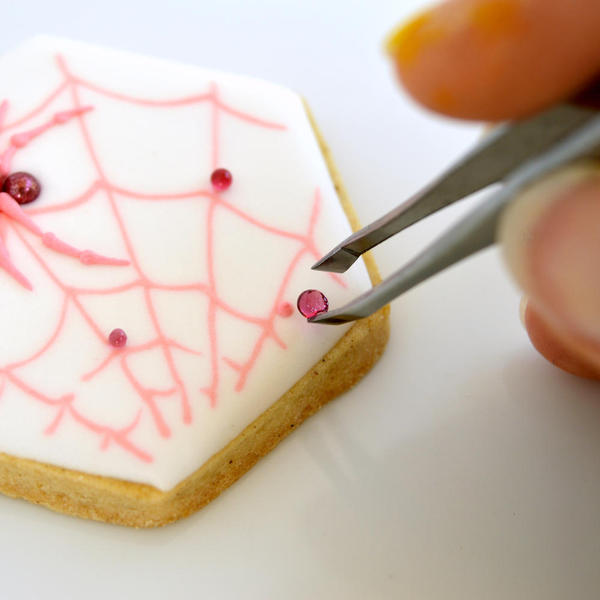
1. Assemble a little flavourless oil in a small receptacle, tweezers, some tissue or kitchen paper, a scribe tool, the hard candy droplets, and your stiff coloured icing.
2. Dip the tips of the tweezers into the oil and wipe off on the kitchen paper. I found this helped with manipulating the slightly sticky droplets.
3. Pipe a tiny dot of icing where you want your droplet attached on the web.
4. Select the droplet and carefully pick it off the paper with the tweezers. Pop it onto the dot of icing, and if necessary use the scribe tool to release it from the tweezers.
5. Repeat as desired.
I discovered that paler droplets placed on different colour icing glowed with that colour. So although I only made light and dark pink droplets, I was able to create orange and blue droplets on the cookies.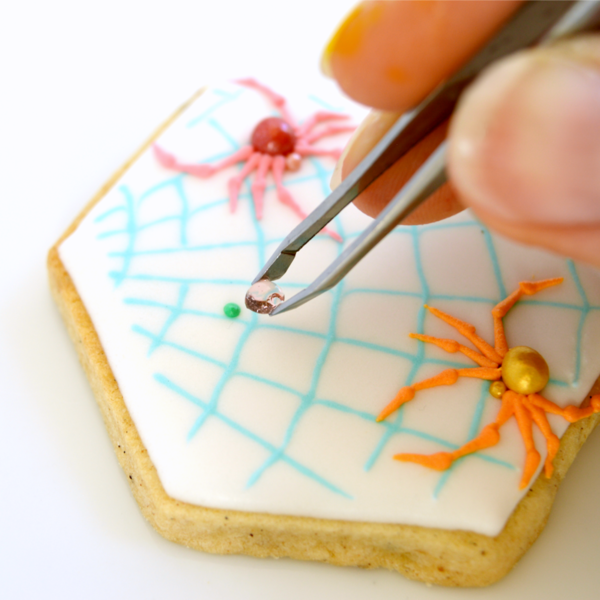
And there you have it. Spiders for Christmas. Or Halloween. Or maybe just afternoon tea.
Cookie and photo credits: Lucy Samuels


Photo credit: Lucy Samuels
Note: What's New, Honeycat? is a bimonthly Cookie Connection blog feature written by Lucy Samuels, which pushes the cookie envelope every other month with innovative cookie design ideas and tutorials. Its content expresses the views of the author and not necessarily those of this site, its owners, its administrators, or its employees. To catch up on all of Lucy's past posts, click here.

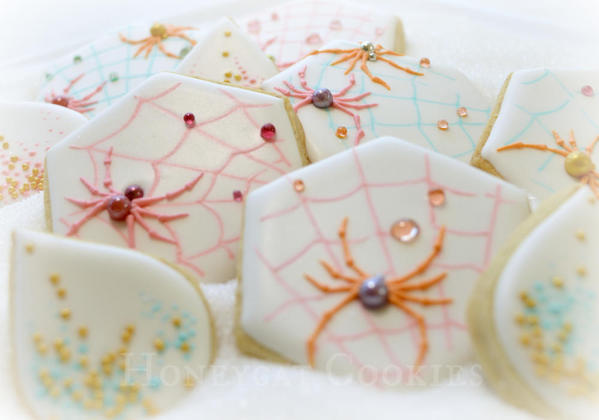
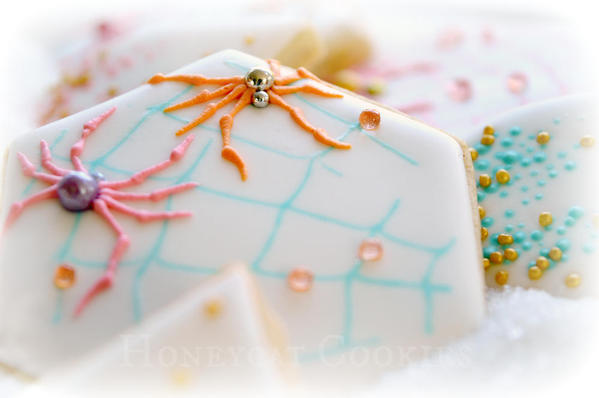

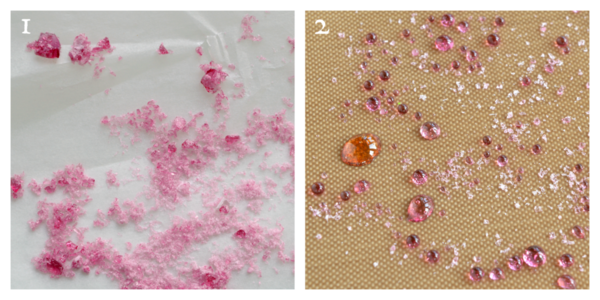
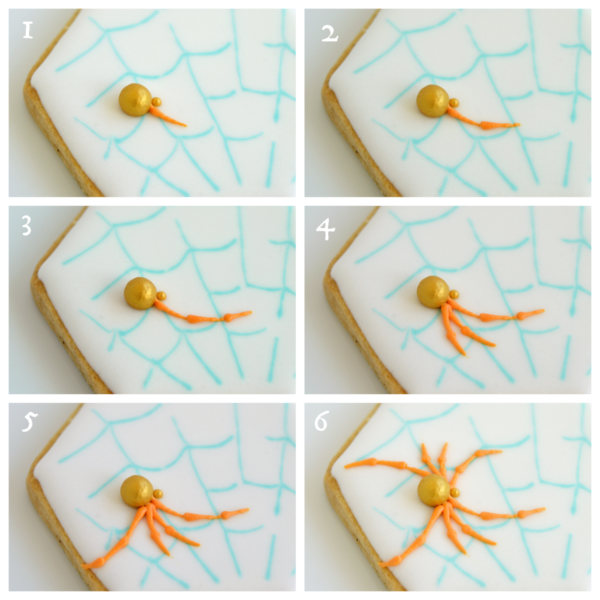


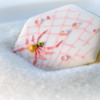
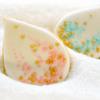
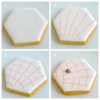

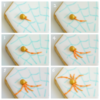



Comments (23)